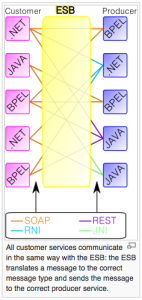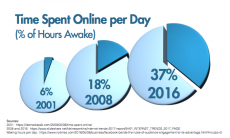A question I often hear when speaking about how social collaboration technologies can make us all more productive is: if the organization becomes more productive, wouldn’t that make workers superfluous? The more I see how the evolution of Social Business software plays out in large organizations, the more I’m convinced that the opposite is true. When well deployed, Social Business solutions enable a workforce that is more informed, skilled, and engaged: those who use it effectively become indispensable for the organization.
In a past life, I was a Solutions Architect, and spent a good deal of my time coming up with better ways to have very disparate computer systems talking to each other smoothly. One of these approaches was called the Enterprise Service Bus. The Wikipedia definition of it probably sounds like something said in an obscure foreign language to most mortals:
An enterprise service bus (ESB) is a software architecture model used for designing and implementing communication between mutually interacting software applications in a service-oriented architecture (SOA). As a software architectural model for distributed computing it is a specialty variant of the more general client server model and promotes agility and flexibility with regards to communication between applications. Its primary use is in enterprise application integration (EAI) of heterogeneous and complex landscapes.
Drawing it does not help much either:

However, if you look at the shapes and forget about the technical jargon, you can understand what it is trying to do. You have lots of very complex and independent “things” on the left and right sides of the “bus”, and the ESB is the conduit that makes sense of them. Actual computer systems have experienced different levels of success with this architecture, but in real office life, that pattern already exists and has been successful for decades. The role of “implementing communication between mutually interacting elements” is actually performed by people, and the peripheral boxes are not necessarily computer systems. They can be business processes, telephone systems, forms, other people, applications, other business organizations, office stationary, and even furniture.
As acronyms go, the next one in the “as a Service” series (SaaS, PaaS, IaaS, MBaaS) is probably KaaS (Knowledge as a Service). Knowledge Management (KM) experts have been trying to find the Holy Graal of information management for so long that they might be missing the obvious. The perfect KaaS system may not be that super Watson computer that will know the answers for everything, nor the Google Oracle that indexes and catalogs every piece of information tidily under a perfect taxonomy. It may simply be a network of people who can handle messy and incomplete information and still get the work done every day.
Naturally, good information systems help, but they don’t replace the human component. Maybe those magical systems will exist in the future, but they are definitely not available now. Just think about a handful of really hard things you did at your workplace over the last year, such as dealing with a difficult client, organizing an office event or launching a new product. How many complex decisions and interactions with other people did you have to have to complete those tasks? Watson can be much better than you or me answering questions about Beatles songs, Olympic history, or book characters, but can it even fully handle a year-end celebration gathering for your team?
Social Business platforms often are seen as very rudimentary by those who believe all enterprise knowledge can be perfectly stored, organized and curated by business processes and computers. The strength of Social Business platforms is actually the simplicity of the concept. Those platforms just accelerate a process that already exists in your organization. They allow enough knowledge to flow more easily from the place it rests (e.g.: your brain) to the places where it is needed (somebody else’s brain), by digitizing incomplete information sets, making people and their personal networks the conduits and the crafters of the final product. The actual complex processing and decision making do not happen in the computer systems, but in the flesh network. The moment you realize that, you’ll stop trying to make your social platform the next perfect KM system, and focus instead in maximizing the value it already gives you: an enhanced network of good people, enough content, and meaningful digital places where the main component is human, not technical.





